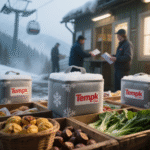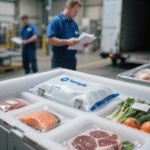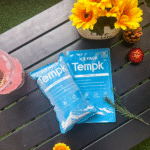Sac de glace sèche pour road trip: How to Pack and Stay Safe
UN dry ice bag for road trip keeps food frozen, cuts mess, and saves cooler space. You’ll learn exact bag sizes, Emballage étape par étape, and simple safety rules that work in real cars. Dry ice is −109.3°F (−78,5 ° C), lasts days in a quality cooler, and leaves no meltwater—so steaks stay solid and salads stay crisp. You focus on the drive; your cooler does the rest.
-
How does a dry ice bag keep food frozen for days? (dry ice in cooler, sub‑zero storage)
-
How much dry ice do you need for your cooler size? (how much dry ice per day)
-
What are the safest packing and ventilation steps in a car? (dry ice safety in car)
-
Which bag and cooler combo delivers the best results? (insulated paper bag, rotomolded cooler)
How does a dry ice bag for road trip keep food frozen?
Réponse rapide: Dry ice absorbs heat as it sublimates, holding sub‑zero temps without meltwater. Place the bag high in the cooler when you want items to stay frozen because cold air sinks. Planifier grossièrement 5–10 lb par jour depending on cooler size, isolation, et à quelle fréquence tu ouvres le couvercle.
Pourquoi ça marche pour vous: Dry ice turns from solid to gas, so it never floods your foods. A strong kraft‑paper, insulated bag slows heat gain and keeps the block off direct contact with produce. In road‑trip use, position the bag at the haut for maximum freeze or under a cardboard/towel layer when you want “chilled, not rock‑hard.” Keep the cooler shaded and full to reduce warm air gaps.
How much dry ice do you actually need per day?
Règle: Commencer par 5–10 lb / jour; scale up for hot weather, thin coolers, or frequent opening. Keep sensitive foods (légumes verts, œufs) away from direct contact to avoid over‑freezing.
| Taille plus froide & Bag Plan | Typical Dry Ice (kg) | Durée prévue | Ce que cela signifie pour vous |
|---|---|---|---|
| 20–30 qt + 1 sac | 10 | 1–2 jours | Great for an overnight loop; minimal babysitting. |
| 40 QT + 2 sacs | 20 | 2–3 jours | Ideal family weekend; keep lid closed between stops. |
| 60 QT + 3 sacs | 30 | 3–4 jours | Des voyages plus longs; pre‑chill foods for best results. |
| 100 QT + 5 sacs | 50 | 5–7+ days | Group travel; heavy—secure the load carefully. |
Practical tips that prevent waste
-
Pre‑chill or pre‑freeze everything; dry ice lasts longer when it’s not doing the heavy lifting.
-
Remplir les vides with towels or newspaper so warm air doesn’t circulate.
-
Split coolers: snacks on regular ice, frozen foods with dry ice.
-
Shade wins: reflective cover or trunk shade slows sublimation.
Instantané réel: On a two‑day desert drive, a 40‑qt cooler plus 20 kg in two paper bags kept meats and ice cream frozen. After moving the cooler to a ventilated cargo area and cracking windows, CO₂ symptoms (mild headache) stopped, and the rest of the trip was uneventful.
How do you pack a dry ice bag for road trip safely?
Short take: Utilisez un, refroidisseur isolé; never seal CO₂ in. Portez des gants, keep the bag off direct food contact, and ventilate the vehicle. Limit storage in enclosed cabins; crack windows or route outside air through vents whenever you carry dry ice in the car.
Emballage étape par étape (3 minutes):
-
Line the base with a thin towel or cardboard to protect plastics.
-
Load frozen foods at the bottom, tight‑packed.
-
Add the dry ice bag on top for “stay frozen” mode; add a barrier if you only want “chilled.”
-
Combler les lacunes with towels/newspaper; close the lid firmly but pas hermétique.
-
Place in a ventilated cargo area, Pas une cabine de passagers scellée.
Ventilation rules in cars that actually matter
-
Keep a window cracked or HVAC on fresh‑air intake, not recirculate.
-
Faire pas sleep in a vehicle with dry ice present.
-
Check symptoms (mal de tête, fast breathing). If they appear, pull over, portes ouvertes, and move the cooler to a ventilated area.
Which dry ice bag and cooler combo should you choose?
Best match: Reinforced kraft‑paper, multilayer insulated bag + rotomolded cooler with good gaskets but pas hermétique. Look for breathable seams or tiny vent paths so CO₂ can escape. For humid trips, considérer un poly‑lined kraft bag with venting to control condensation.
Bag types compared
| Type de sac | Points forts | Watch-bots | Meilleure utilisation |
|---|---|---|---|
| Open‑mouth paper | Easy loading, flexible sizing | Less structural strength | Small blocks, parcours courts |
| Gusseted/sewn kraft | Forte résistance, rough‑handling ready | Slightly harder to open | Des voyages plus longs, big blocks |
| Poly‑lined kraft | Barrière d'humidité | Must have venting | Humid climates, été |
| Insulated paper tote | Réutilisable, murs plus épais, poignées | Coût plus élevé | Frequent travelers |
2025 trends that affect your dry ice bag for road trip
Quoi de neuf: Sustainable dry ice is rising as suppliers lean on Co₂ recyclé and carbon‑capture. Smart cooler accessories now include capteurs de température et de CO₂ that alert your phone, reducing lid‑checks. Modular coolers create two‑zone storage, so greens don’t freeze while steaks stay solid. These trends make a dry ice bag for road trip safer, nettoyeur, and easier than ever.
Dernier en un coup d'œil
-
Recycled CO₂ supply: Lower footprint without sacrificing performance.
-
Phone‑linked sensors: Know when to vent or add ice—no lid peeking.
-
Modular dividers: Build frozen and chilled zones in one cooler.
Perspicacité du marché: With outdoor travel and cold‑chain awareness growing, blocks and pellets still dominate, alors que insulated paper packaging et smart add‑ons développer. Expect clearer sustainability labels (contenu recyclé, end‑of‑life) Et plus custom bag sizes that fit common cooler footprints.
FAQs about dry ice bag for road trip
1) Is it safe to drive long distances with dry ice in the car?
Yes—if you ventilate. Place the cooler in a cargo area, crack windows, éviter les contenants hermétiques, and never sleep in the vehicle with dry ice.
2) How do I stop lettuce and drinks from freezing?
Create a barrier (cardboard/towel) and keep sensitive items in a separate section or separate cooler with regular ice.
3) Can any cooler handle dry ice?
Use insulated coolers that aren’t airtight. Some thin plastics may become brittle at −109°F; protect with towels or cardboard.
4) What do I do with leftover dry ice?
Let it sublimate outdoors in a ventilated area, away from kids and pets. Don’t put it in sinks or sealed bins.
5) How much should I buy before departure?
Purchase as close to departure as practical. Plan 5–10 lb / jour and adjust for heat, access frequency, and cooler quality.
Résumé & étapes suivantes
En bref: UN dry ice bag for road trip delivers days of sub‑zero cooling without mess. Taille à 5–10 lb / jour, pack the bag high for freezing, and ventilate the vehicle at all times. Choose reinforced kraft bags and rotomolded coolers for maximum hold.
Fais ceci ensuite:
-
Measure your cooler and run the calculator.
-
Buy the right number of bags as close to departure as possible.
-
Pack frozen items tightly, bag on top, gaps filled, and drive with fresh‑air ventilation.
CTA: Ready to build your kit? Contacter le tempk for tailored bag sizing and cooler guidance.
À propos du tempk
We build practical cold‑chain gear for travelers and shippers. Our dry ice bags use reinforced, recyclable kraft avec multilayer insulation et breathable seams to extend ice life while protecting your food and your cooler. We also support sustainable sourcing by favoring Co₂ recyclé supply where available and offer custom sizes that match popular cooler footprints.
Prochaine étape: Get expert packing advice or request a custom bag size—talk to Tempk today.
























